Design Method for Freeform Off-Axis Three-Mirror Anastigmat Optical Systems with a Large Field of View and Low Error Sensitivity
Abstract
1. Introduction
2. Error Sensitivity Analysis and Merit Function
3. Design Method for Freeform Off-Axis TMA Optical Systems with a Large FOV and Low Error Sensitivity
- (1)
- Construct the initial system of the optical system based on the design requirements and set the initial structural constraints.
- (2)
- Set the conditions for FOV expansion and error sensitivity constraints for the N + 1th round (starting from the initial system, N = 0):
- Set the error sensitivity threshold. Calculate the evaluation function value MF based on the existing FOV and set it as the threshold for the sensitivity evaluation. The error sensitivity in the subsequent design process should be lower than MF.
- FOV expansion. Set the step length for expanding the FOV of the optical system based on the requirements. Gradually expand the FOV in the meridional and sagittal directions with a certain step length.
- Set error sensitivity constraints. After the FOV expansion, recalculate the evaluation function value MF′ for all FOVs. Control the MF′ value of the newly added FOV to be lower than the threshold MF. This is the error sensitivity constraint condition.
- (3)
- Image quality optimization. Recalculate the structural constraints and optimize the image quality of the optical system based on the structural constraints and error sensitivity constraints. If the optical system does not meet the image quality requirements, increase the DOFs of the optical system, such as upgrading the surface type to freeform surfaces, until the image quality meets the requirements.
- (4)
- Determine if the FOV meets the requirements. If it does, output the freeform off-axis TMA system with a large FOV and low error sensitivity that meets the image quality requirements. If it does not meet the requirements, return to step (2).
4. Design Example
4.1. Construct Initial System
4.2. FOV Expansion and Error Sensitivity Optimization
4.3. Error Sensitivity Analysis
5. Discussion
5.1. Discussion of the Desensitization Design Method
5.2. Discussion of the Combined Design Method and Design Results
6. Conclusions
Author Contributions
Funding
Data Availability Statement
Conflicts of Interest
References
- Liu, X.; Gong, T.; Jin, G.; Zhu, J. Design method for assembly-insensitive freeform reflective optical systems. Opt. Express 2018, 26, 27798–27811. [Google Scholar] [CrossRef]
- Yang, T.; Zhu, J.; Hou, W.; Jin, G. Design method of freeform off-axis reflective imaging systems with a direct construction process. Opt. Express 2014, 22, 9193–9205. [Google Scholar] [CrossRef] [PubMed]
- Qin, Z.; Qi, Y.; Ren, C.; Wang, X.; Meng, Q. Desensitization design method for freeform TMA optical systems based on initial structure screening. Photonics 2022, 9, 544. [Google Scholar] [CrossRef]
- Zhang, B.; Jin, G.; Zhu, J. Towards automatic freeform optics design: Coarse and fine search of the three-mirror solution space. Light Sci. Appl. 2021, 10, 65. [Google Scholar] [CrossRef] [PubMed]
- Lampton, M.L.; Sholl, M.J.; Levi, M.E. Off-axis telescopes for dark energy investigations. Proc. SPIE 2010, 7731, 442–452. [Google Scholar]
- Figoski, J.W. Alignment and test results of the QuickBird telescope using the Ball Optical System Test Facility. In Advanced Telescope Design, Fabrication, and Control. Proc. SPIE 1999, 3785, 99–108. [Google Scholar]
- Hariharan, V.K.; Sundaram, N.S.; Dayashankara, K.S.; Lakshminarayana, V.; Shrivastava, A.K.; Damodaran, A.; Gupta, L.N.; Ganeshan, P.P.; Velayudhan, M.; Rao, B.V.; et al. Assembly, integration and testing of Cartosat-1. In Proceedings of the 2006 9th International Conference on Electromagnetic Interference and Compatibility, Bangalore, India, 23–24 February 2006; IEEE: Piscataway, NJ, USA, 2006; pp. 60–66. [Google Scholar]
- Meng, Q.; Wang, D.; Wang, X.; Li, W.; Yang, X.; Yan, D.; Li, Y.; Cao, Z.; Ji, Q.; Sun, T.; et al. High resolution imaging camera (HiRIC) on China’s first Mars exploration Tianwen-1 mission. Space Sci. Rev. 2021, 217, 42. [Google Scholar] [CrossRef]
- Thompson, K.P.; Rolland, J.P. Freeform Optical Surfaces: A Revolution in Imaging Optical Design. Opt. Photonis News 2012, 23, 30–35. [Google Scholar] [CrossRef]
- Wei, S.; Li, Y.; Ma, D. Sculpting optical fields into caustic patterns based on freeform optics. Optica 2023, 10, 1688–1699. [Google Scholar] [CrossRef]
- Wei, S.; Zhu, Z.; Ma, D. Efficient and compact freeform optics design for customized LED lighting. Opt. Laser Technol. 2023, 167, 109775. [Google Scholar] [CrossRef]
- Zhong, Y.; Gross, H.; Broemel, A.; Kirschstein, S.; Petruck, P.; Tuennermann, A. Investigation of TMA systems with different freeform surfaces. Proc. SPIE 2015, 9626, 229–238. [Google Scholar]
- Zhang, X.; Zhang, J.; Shi, G.; Wu, Y.; Wang, L.; Zeng, F.; Qu, H.; Zhang, J.; Wu, H.; Zhu, Y.; et al. Optical design of off-axis astronomical space telescope based on freeform surfaces. Proc. SPIE 2014, 9293, 198–205. [Google Scholar]
- Reimers, J.; Bauer, A.; Thompson, K.P.; Rolland, J.P. Freeform spectrometer enabling increased compactness. Light Sci. Appl. 2017, 6, e17026. [Google Scholar] [CrossRef]
- Yang, T.; Zhu, J.; Jin, G. Design of free-form imaging systems with linear field-of-view using a construction and iteration process. Opt. Express 2014, 22, 3362–3374. [Google Scholar] [CrossRef]
- Tang, R.; Zhang, B.; Jin, G.; Zhu, J. Multiple surface expansion method for design of freeform imaging systems. Opt. Express 2018, 26, 2983–2994. [Google Scholar] [CrossRef]
- Hou, W.; Zhu, J.; Yang, T.; Jin, G. Construction method through forward and reverse ray tracing for a design of ultra-wide linear field-of-view off-axis freeform imaging systems. J. Opt. 2015, 17, 055603. [Google Scholar] [CrossRef]
- Meng, Q.; Wang, H.; Liang, W.; Yan, Z.; Wang, B. Design of off-axis three-mirror systems with ultrawide field of view based on an expansion process of surface freeform and field of view. Appl. Opt. 2019, 58, 609–615. [Google Scholar] [CrossRef]
- Gu, Z.; Wang, Y.; Yan, C. Optical system optimization method for as-built performance based on nodal aberration theory. Opt. Express 2020, 28, 7928–7942. [Google Scholar] [CrossRef] [PubMed]
- Kuper, T. A new look at global optimization for optical design. Photonics Spectra 1992, 1, 151–160. [Google Scholar]
- Kuper, T. Global optimization finds alternative lens designs. Laser Focus World 1992, 5, 193–195. [Google Scholar]
- Forbes, G.; Jones, A. Global Optimization in Lens Design. Opt. Photonics News 1992, 3, 23–29. [Google Scholar] [CrossRef]
- Sturlesi, D.; O’Shea, D.C. Global view of optical design space. Opt. Eng. 1991, 30, 207–218. [Google Scholar] [CrossRef]
- Fuse, K. Method for Designing a Refractive or Reflective Optical System and Method for Designing a Diffraction Optical Element. US Patent No 6567226 20 May 2003. [Google Scholar]
- Rogers, J.R. Using global synthesis to find tolerance-insensitive design forms. Proc. SPIE 2006, 6342, 63420M. [Google Scholar]
- Isshiki, M.; Gardner, L.; Gregory, G.G. Automated control of manufacturing sensitivity during optimization. Proc. SPIE 2004, 5249, 343–352. [Google Scholar]
- Jeffs, M. Reduced manufacturing sensitivity in multi-element lens systems. Proc. SPIE 2002, 4832, IMC4. [Google Scholar]
- Qin, Z.; Wang, X.; Ren, C.; Qi, Y.; Meng, Q. Design method for a reflective optical system with low tilt error sensitivity. Opt. Express 2021, 29, 43464–43479. [Google Scholar] [CrossRef]
- Meng, Q.; Wang, H.; Wang, W.; Yan, Z. Desensitization design method of unobscured three-mirror anastigmatic optical systems with an adjustment-optimization-evaluation process. Appl. Opt. 2018, 57, 1472–1481. [Google Scholar] [CrossRef]
- Qin, Z.; Meng, Q.; Wang, X. Desensitization design method of a freeform optical system based on local curve control. Opt. Lett. 2023, 48, 179–182. [Google Scholar] [CrossRef]
- Deng, Y.; Jin, G.; Zhu, J. Design method for freeform reflective-imaging systems with low surface-figure-error sensitivity. Chin. Opt. Lett. 2019, 17, 092201. [Google Scholar] [CrossRef]
- Sasian, J.; Descour, M. Power distribution and symmetry in lens systems. Opt. Eng. 1998, 37, 1001–1005. [Google Scholar] [CrossRef]
- Deng, Y.; Tan, Y.; Wu, X.; Zhu, J. Local tolerance and quality evaluation for optical surfaces. Optica 2022, 9, 1039–1049. [Google Scholar] [CrossRef]
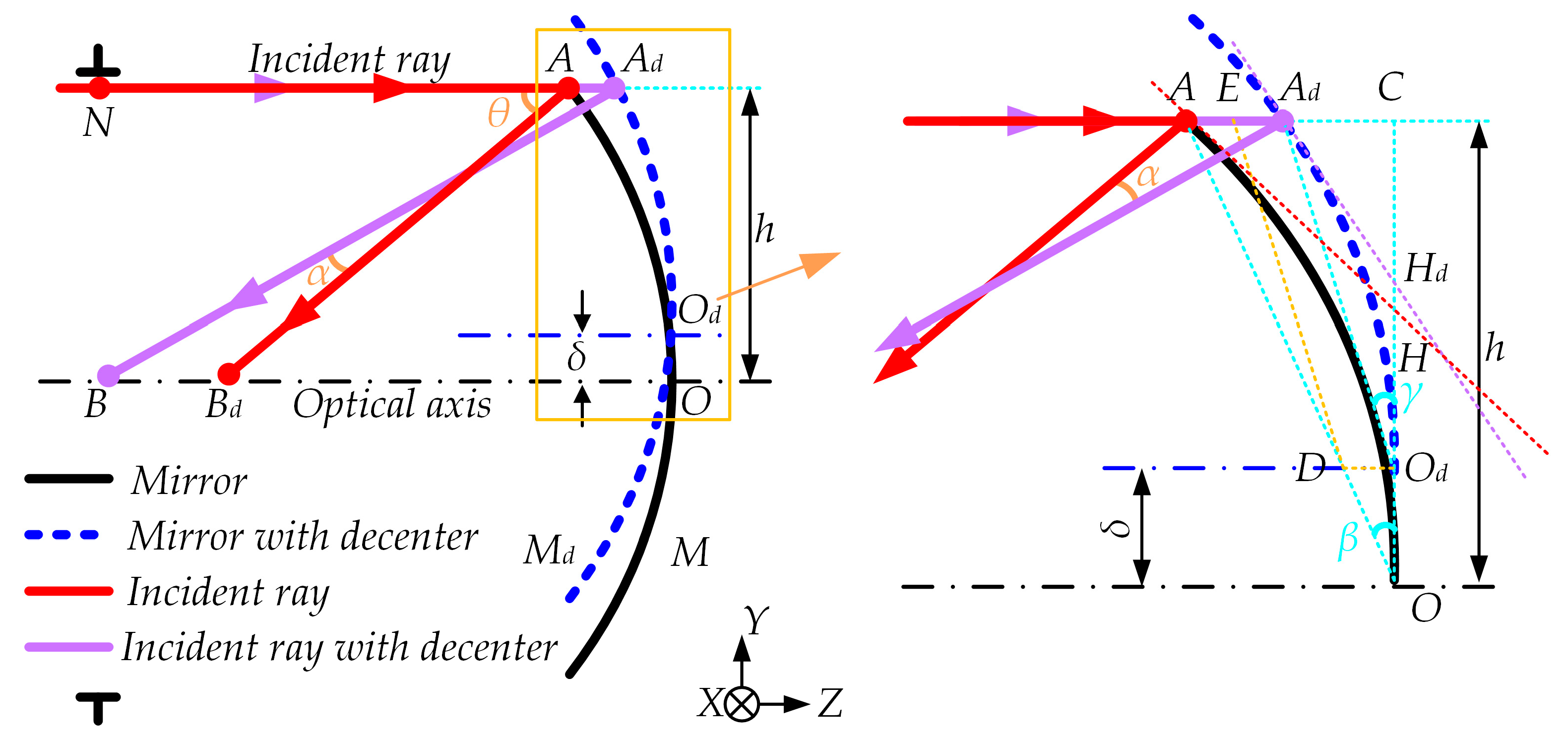
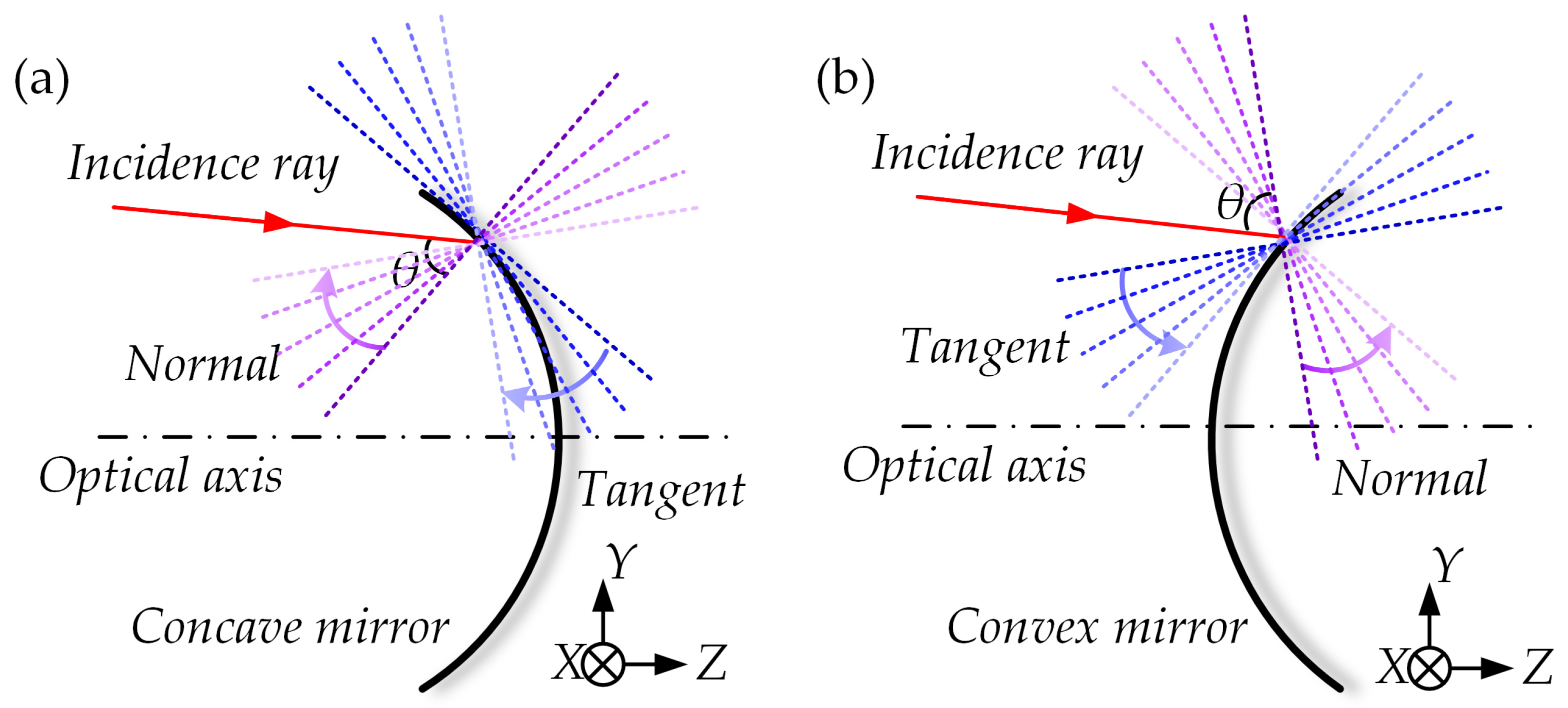
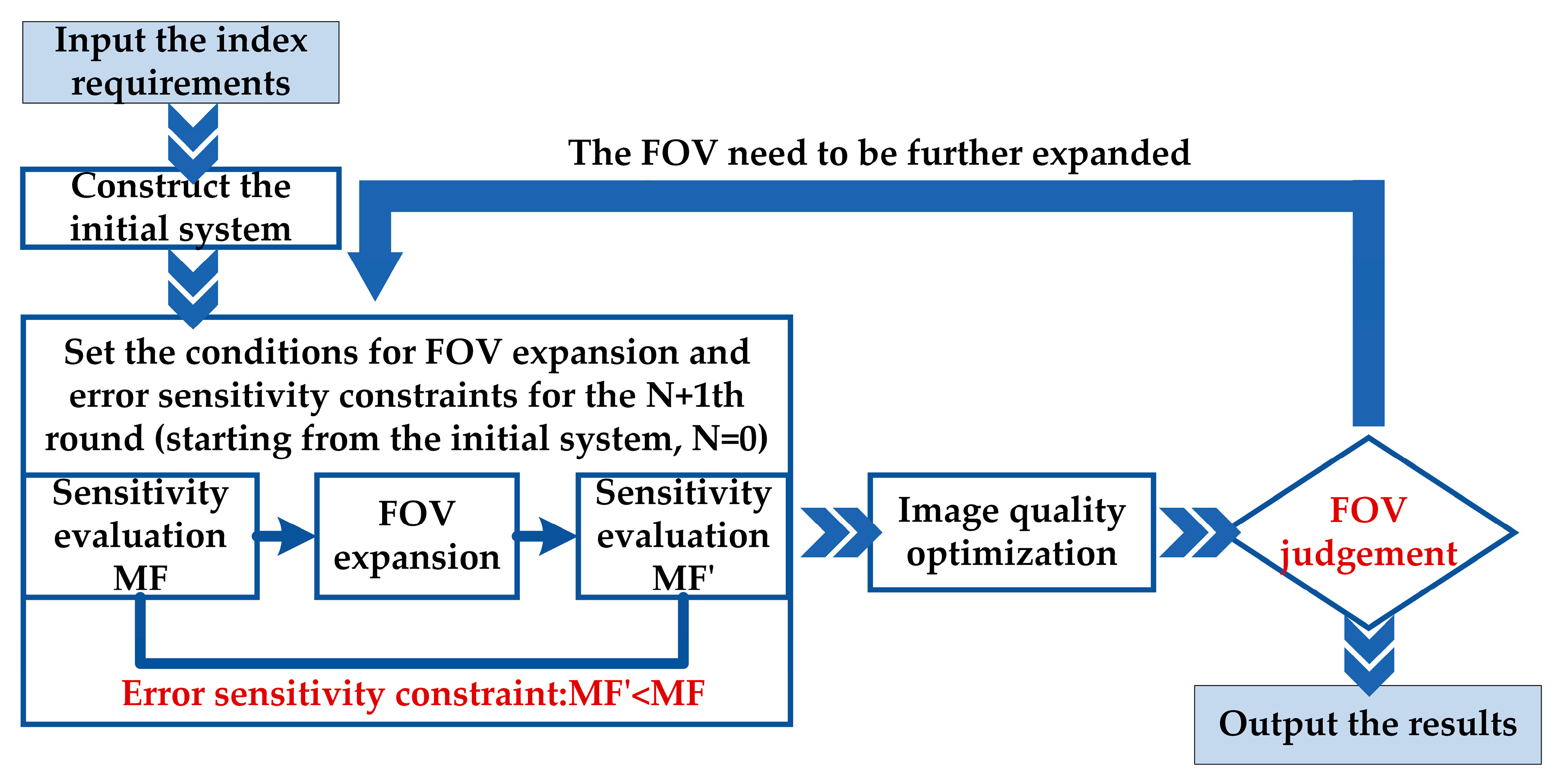
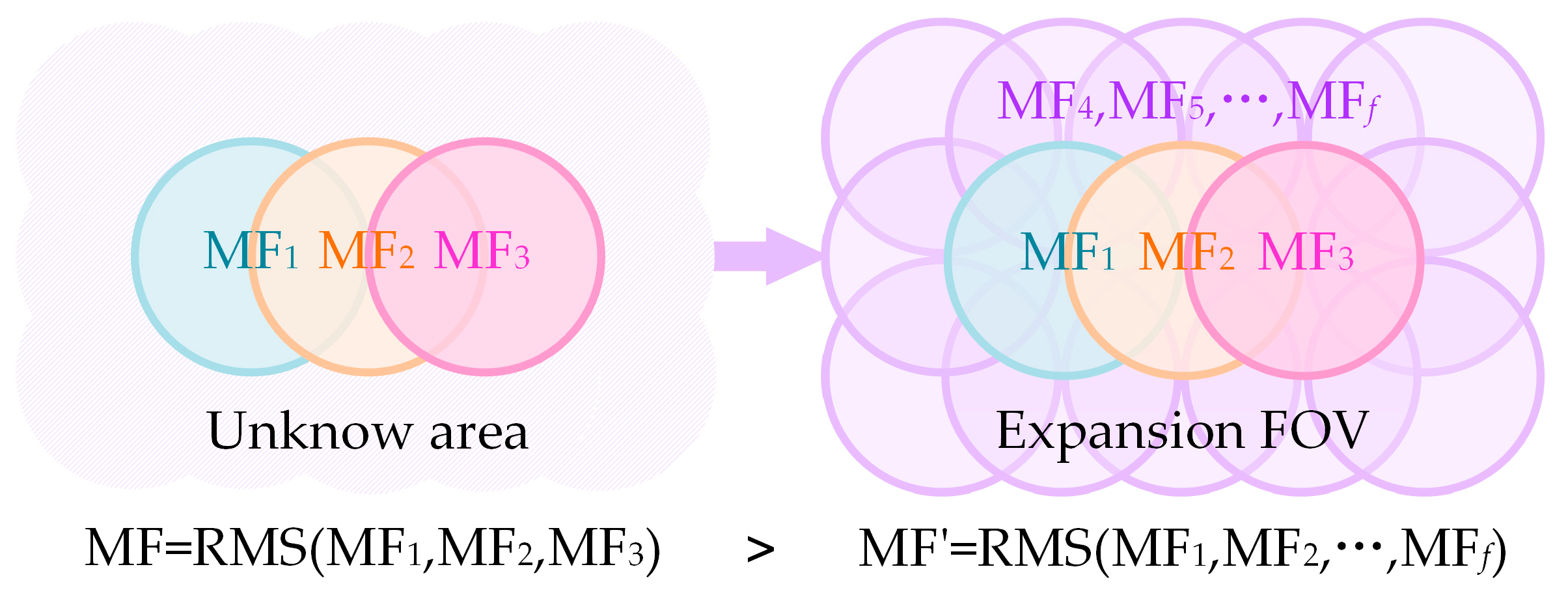

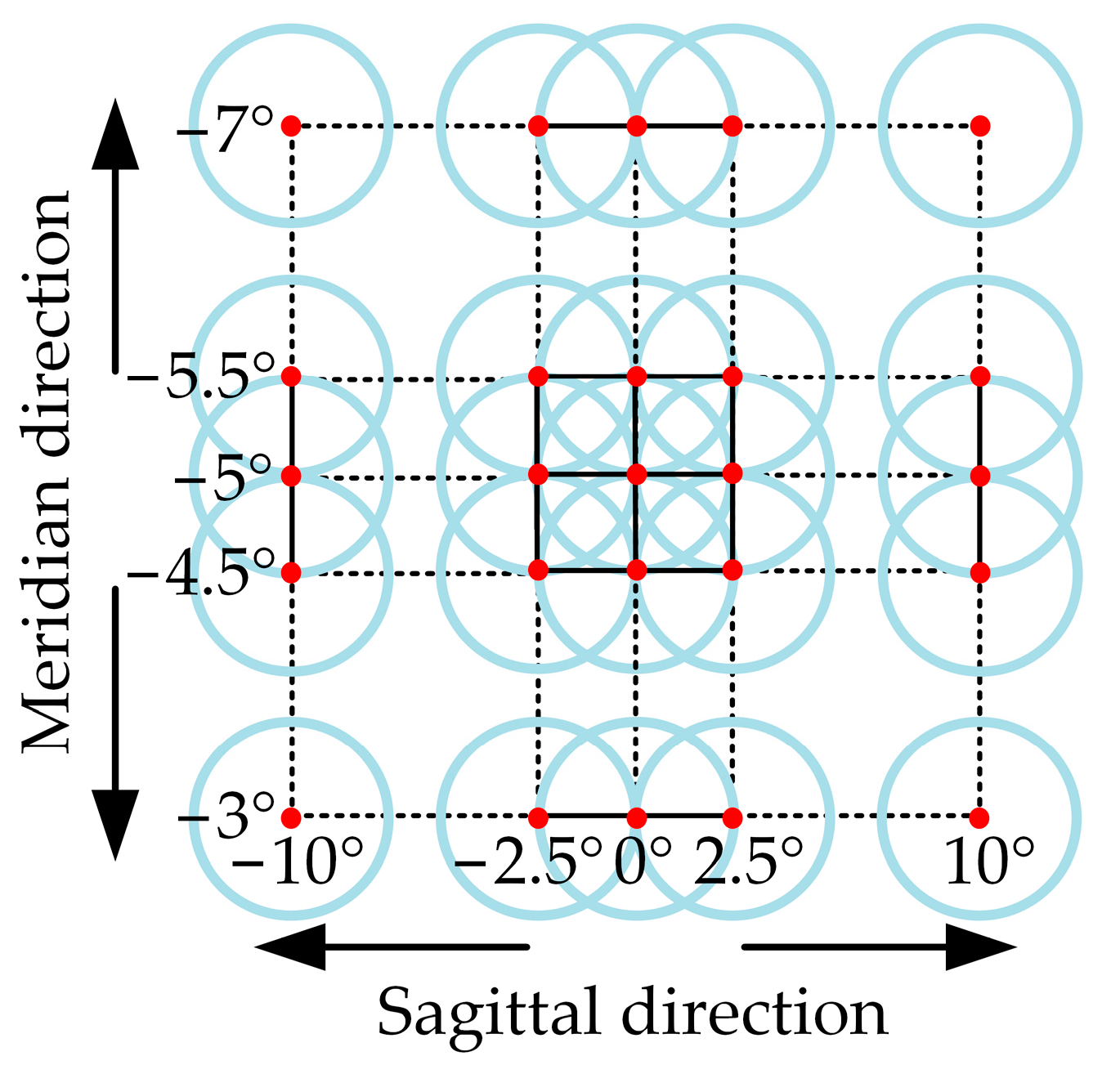

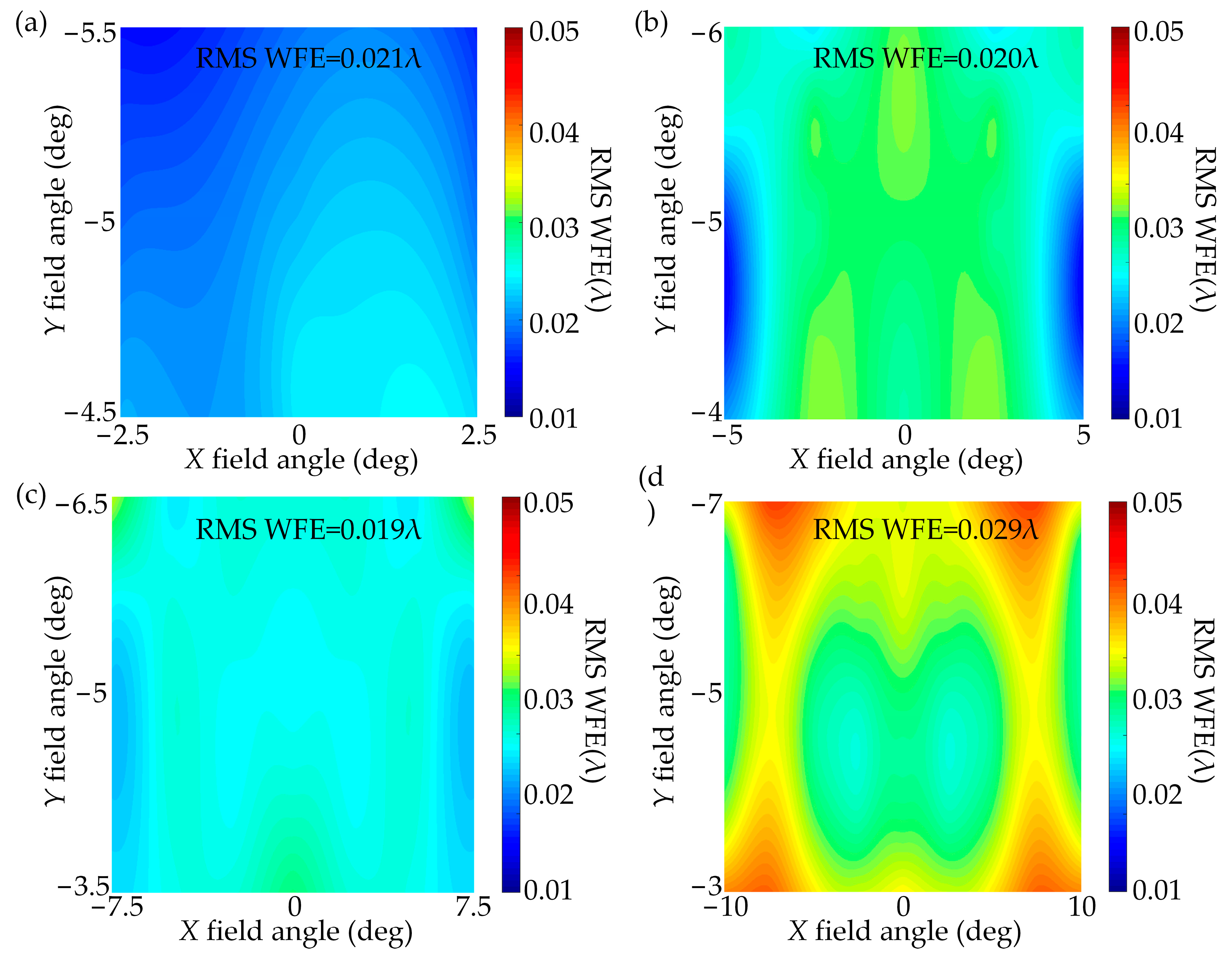
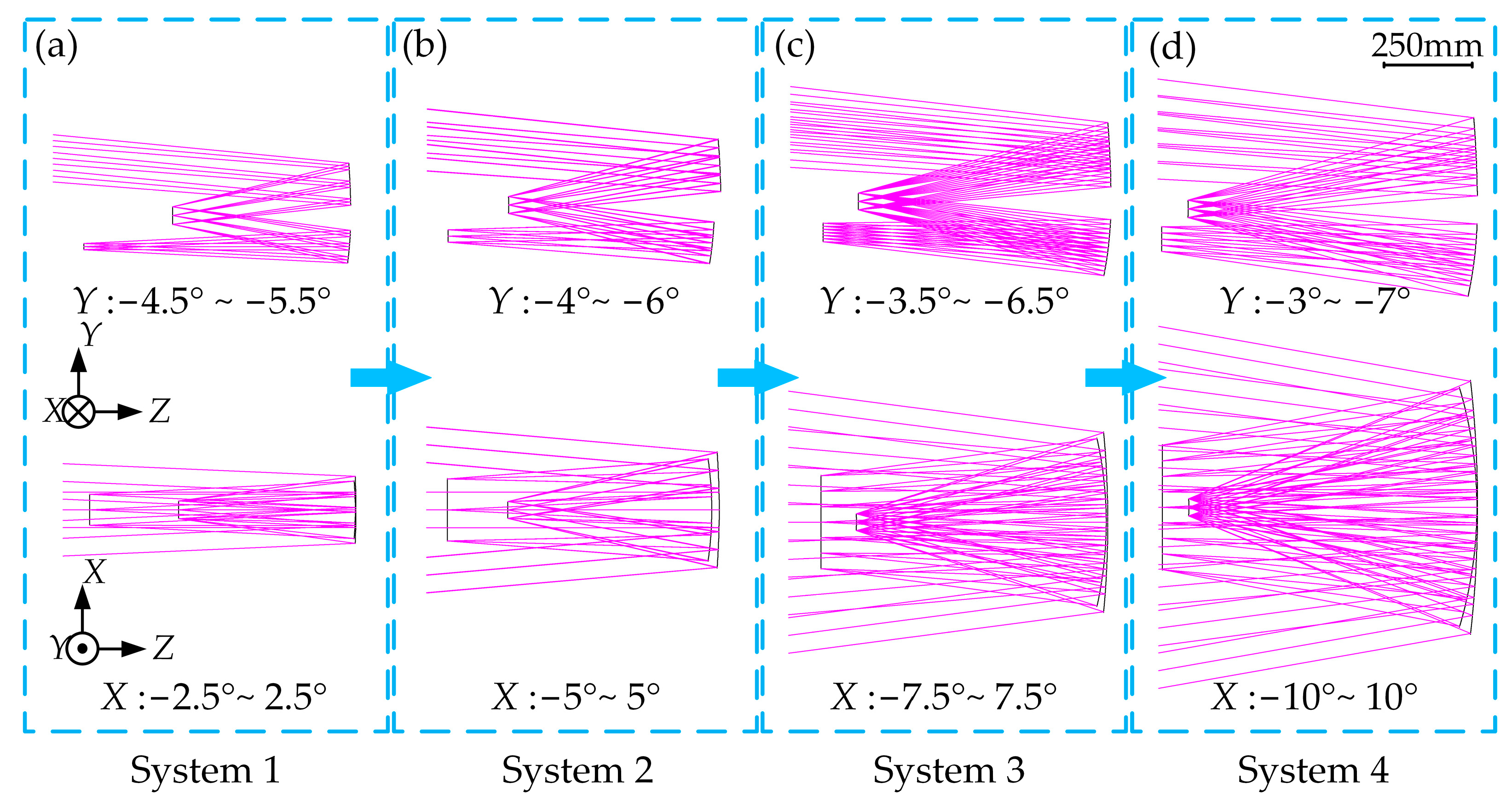
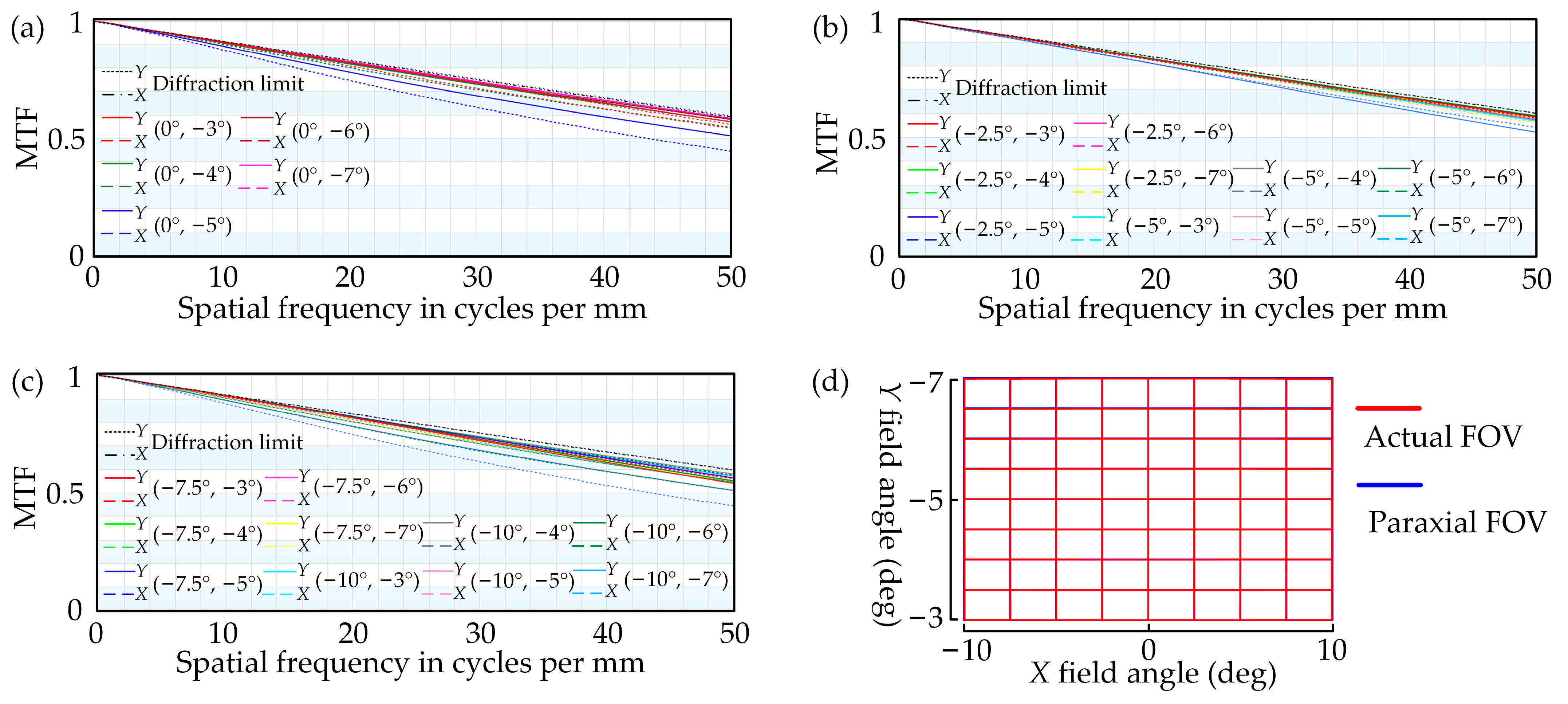

| Index | Requirement |
|---|---|
| Focal length | 1000 mm |
| F-number | 10 |
| FOV | 20° × 4° |
| MTF | 0.45@50 lp/mm |
| Distortion | 0.5% |
Disclaimer/Publisher’s Note: The statements, opinions and data contained in all publications are solely those of the individual author(s) and contributor(s) and not of MDPI and/or the editor(s). MDPI and/or the editor(s) disclaim responsibility for any injury to people or property resulting from any ideas, methods, instructions or products referred to in the content. |
© 2024 by the authors. Licensee MDPI, Basel, Switzerland. This article is an open access article distributed under the terms and conditions of the Creative Commons Attribution (CC BY) license (https://creativecommons.org/licenses/by/4.0/).
Share and Cite
Ren, C.; Meng, Q. Design Method for Freeform Off-Axis Three-Mirror Anastigmat Optical Systems with a Large Field of View and Low Error Sensitivity. Photonics 2024, 11, 211. https://doi.org/10.3390/photonics11030211
Ren C, Meng Q. Design Method for Freeform Off-Axis Three-Mirror Anastigmat Optical Systems with a Large Field of View and Low Error Sensitivity. Photonics. 2024; 11(3):211. https://doi.org/10.3390/photonics11030211
Chicago/Turabian StyleRen, Chengming, and Qingyu Meng. 2024. "Design Method for Freeform Off-Axis Three-Mirror Anastigmat Optical Systems with a Large Field of View and Low Error Sensitivity" Photonics 11, no. 3: 211. https://doi.org/10.3390/photonics11030211
APA StyleRen, C., & Meng, Q. (2024). Design Method for Freeform Off-Axis Three-Mirror Anastigmat Optical Systems with a Large Field of View and Low Error Sensitivity. Photonics, 11(3), 211. https://doi.org/10.3390/photonics11030211






